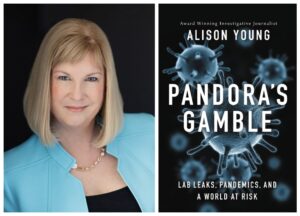
During the pandemic, one of my go-to sources for context was science journalist Jon Cohen. Cohen is a long-time infectious disease reporter and a senior correspondent for Science magazine. He has written more than 100 deeply reported stories about all aspects of SARS-CoV-2, the virus that causes COVID-19, including how the virus impacts the body’s immune system and the global race to access vaccines.
Now that the acute phase of the pandemic is over, the story of where SARS-CoV-2 came from is gaining more prominence. Did it come from an animal? Or from a research lab? The answer remains elusive, though the greater share of evidence points to an animal.
In mid-July 2022, Cohen wrote about a U.S. House of Representatives subcommittee hearing on the origin of COVID-19 during which congressional lawmakers tried to score political points by casting blame. I thought it would be useful for AHCJ members to hear Cohen’s perspective on the ongoing controversy about COVID-19’s origin and advice for covering it, as well as what the important infectious disease stories are now that COVID is no longer a global health emergency.
Responses have been lightly edited for brevity and clarity.
You have always said that you approached the COVID-19 origin story with an open mind. I will have to admit that in February and March 2020, I dismissed the story that it came from the Wuhan Institute of Virology.
You know, this gets mixed up a lot. If you look at a story I wrote on Jan. 31, 2020, there were clear conspiracy theories pushing the lab leak idea. But there were other lab leak scenarios that weren’t [conspiracy theories]. There were conspiracy theories that this was a bioweapon, and those theories were coming from unreliable sources that had strong anti-China biases with no evidence. And the first surge of stories in the media about a lab leak were about a bioweapon. At the same time, there was a possibility [that wasn’t a conspiracy] that the virus wasn’t engineered as a bioweapon [but rather as an experiment]. So, I think it’s important to parse it like that because when people speak about the lab leak, they mean different things.
I just read journalist Alison Young’s book “Pandora’s Gamble” about the history of lab accidents, and I learned just how many lab accidents there have been in the past five decades. So, what do you think about the lab leak theory?
Yeah, lots of lab accidents have happened, but we have to be really careful [with this]. Do laboratory accidents happen and infect people and kill people? Absolutely. There’s no doubt about that. Could the laboratory at the Wuhan Institute of Virology through various scenarios have been the spark of this pandemic? Sure, it could have. [But] show me the evidence that a lab leak sparked the COVID-19 pandemic. What it comes down to is sorting through possibilities and probabilities and moving away from theory and moving toward evidence. Over time, evidence naturally accrues for all of these [infectious disease] origin stories. This isn’t my first origin story rodeo. I’ve covered several origin stories in the past and over time we see evidence that supports or doesn’t support different theories. What we’re witnessing over this three-year period of time is theories are starting to give way to evidence.
And the evidence right now points toward a zoonotic spillover event, that can be traced to probably the illegal sale of wildlife at the Huanan Seafood Market in Wuhan, right?
There are far more published peer-reviewed studies and even preprints, with data and analyses, that support the market origin than there are for the lab leak. So, on that simple metric of number of peer-reviewed publications, there’s no comparison.
What about the evidence that there was a strain of a bat coronavirus at the Wuhan Institute that was genetically 96% similar to SARS-CoV-2 virus?
There was a sequence of the virus that had 96.2% genetic similarity, but they did not grow that virus in a culture. They didn’t grow the vast majority of samples they had. Furthermore, if you do an evolutionary analysis of that virus sequence to SARS-CoV-2, it would have taken a long time to become SARS-CoV-2. That sequence is not closely related to SARS-CoV-2. One is not a precursor virus of the other.
What about the assertion in the U.S. intelligence community that three lab workers had been ill in November with ‘flu-like’ symptoms?
We’ve been told that, but when the evidence is critically analyzed, it melts away. The workers tell me they weren’t sick. The intelligence community in the U.S. has many branches, and they don’t talk to each other. None of them have offered any evidence as to how they came to the conclusions that they came to. The FBI said it had medium confidence in its conclusion that it was a lab leak and the Department of Energy has low confidence in that scenario, but there is no documentation anywhere that tells us anything about how they came to those conclusions.
What advice do you have to journalists who wade into this story and want to cover it, particularly political journalists who are covering these hearings?
I think that there are just fundamental rules of journalism that come into play here. Follow the evidence. Remain open-minded and skeptical about claims. Journalists have the skill set to ferret out reliable information. That’s what we do. Use the same skills here. If it’s an extraordinary claim, it requires extraordinary evidence. There’s a lot of confusion about this because it is being adjudicated in social media. Which isn’t a great venue for figuring this out. Nor is the intelligence community. This is a scientific question. We have more evidence supporting the zoonotic origin here than we do for other theories.
This origin story debate has spurred more discussion about gain-of-function research and whether scientists should be experimenting with risky pathogens because humans who work in labs make mistakes. So, what do you think of the debate about gain-of-function research?
This pandemic has given more attention to gain of function than it has ever received. The public at large didn’t know what gain of function was … and the pandemic has pushed it to the front burner, and it’s a worthy discussion. Lab safety is a worthy discussion.
What infectious disease stories should journalists be covering now?
We always have to be on alert for new things cropping up or for old things cropping up and causing problems. So, it’s monitoring both what’s happening to address things from the past that are major problems in the world, like tuberculosis and malaria, and also watching for each new outbreak of viruses like, Marburg or Ebola or malaria in the United States or a measles outbreak in London caused by under-vaccinating. It’s just keeping an eye on all of it. I look for tools that aren’t being used, that could be used to help people to avoid or survive infectious diseases … Like with HIV, there’s always a challenge of people identifying that they’re infected and accessing medication, or with [tuberculosis], Johnson and Johnson now will allow a generic drug to be made that will enable many people around the world to have access to a medicine that clearly saves lives.









